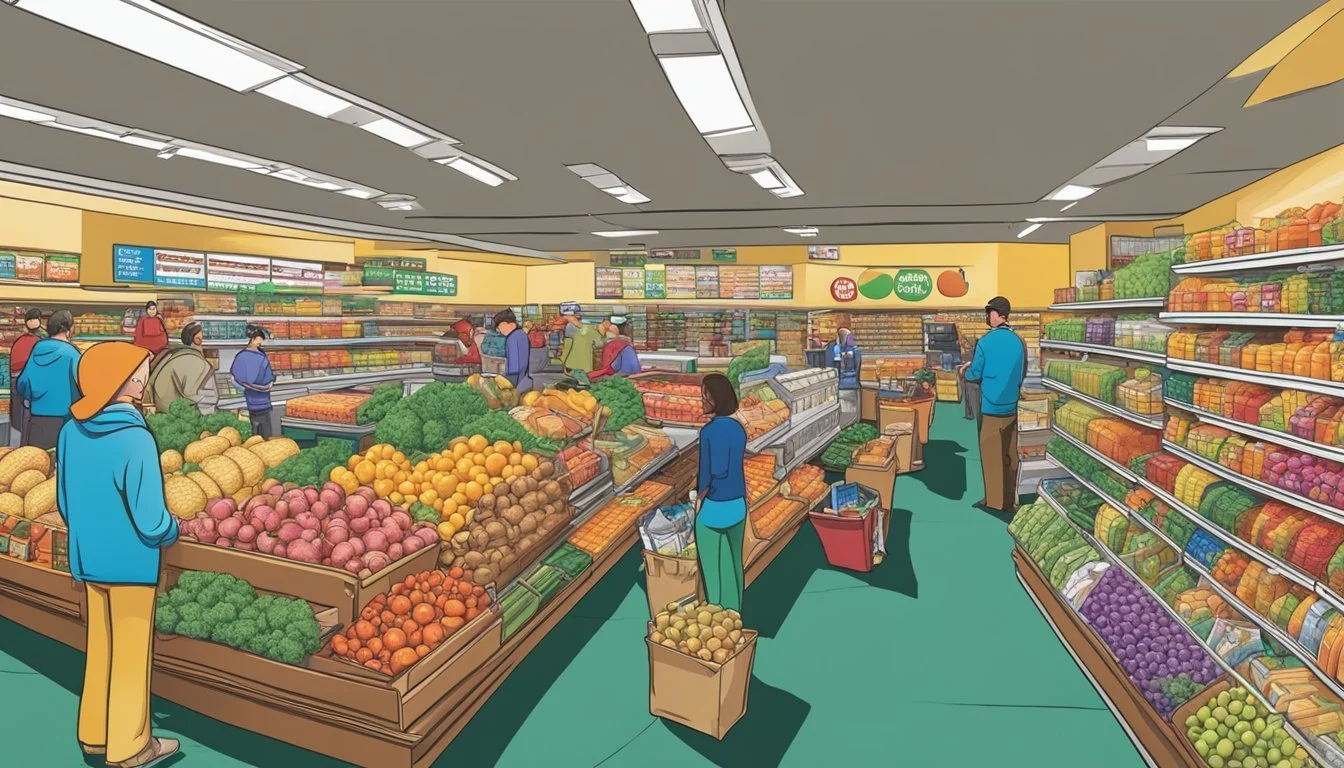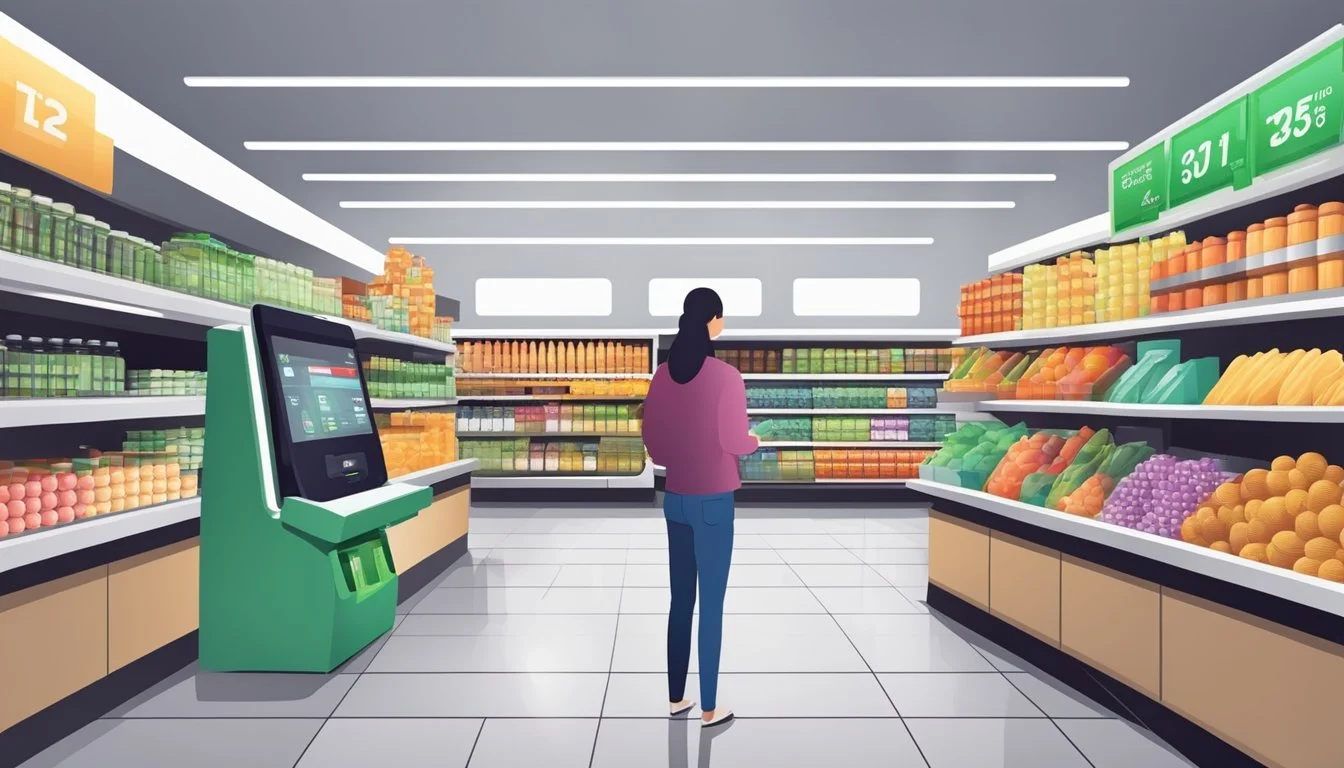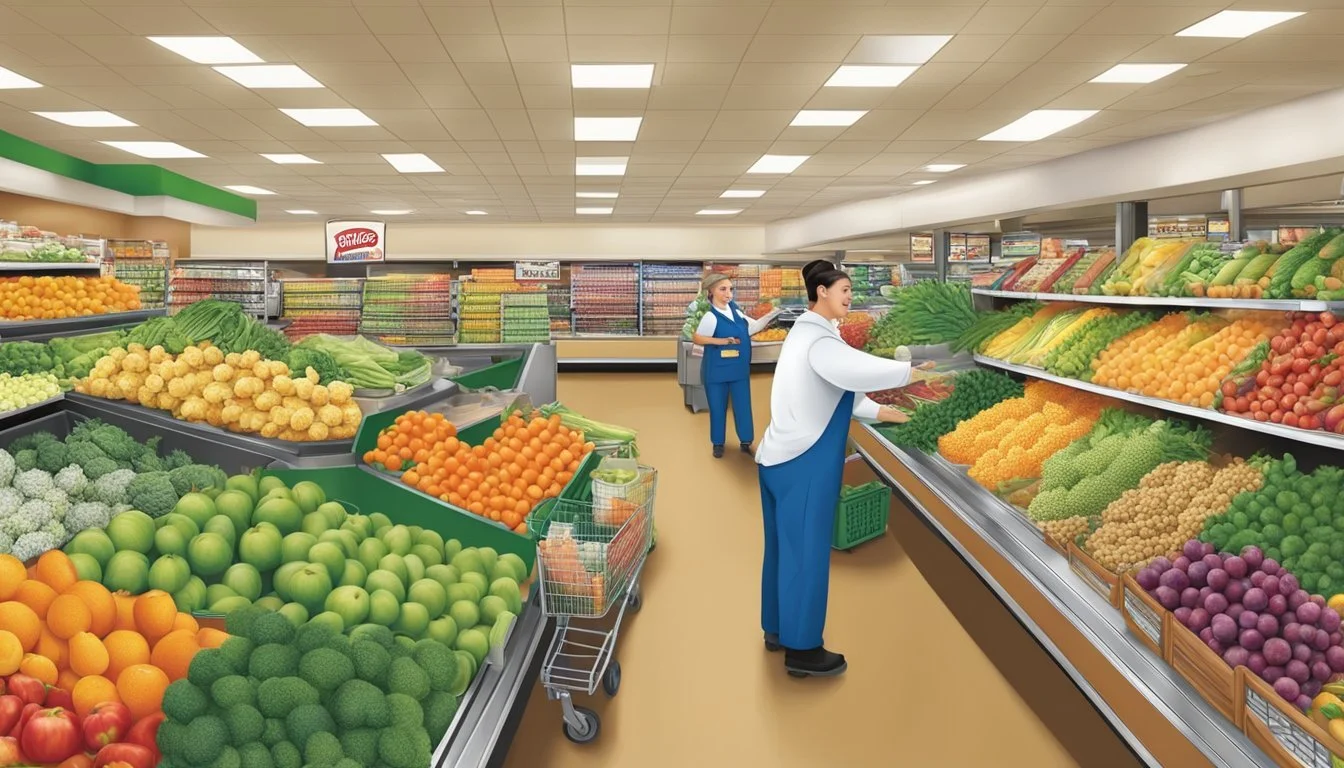Piggly Wiggly vs WinCo Foods
A Comprehensive Comparison of Prices, Selection, and Service
Grocery shopping can be a significant part of household expenses, making the choice of store crucial for many consumers. Piggly Wiggly and WinCo Foods represent two distinct approaches to the supermarket experience, each with its own strengths and loyal customer base.
WinCo Foods outperforms Piggly Wiggly in overall customer satisfaction, ranking among the top 10 highest-rated grocers in the United States. This ranking reflects WinCo's commitment to providing low prices and a wide selection of products, appealing to budget-conscious shoppers who don't want to compromise on variety.
Piggly Wiggly, while not as highly ranked, maintains a dedicated following in certain regions. The chain focuses on offering a more personalized shopping experience in smaller stores, which can be appealing to customers who prefer a quicker, more intimate grocery run. Both stores aim to meet the diverse needs of shoppers, but their approaches and target demographics differ significantly.
History and Background
Piggly Wiggly and WinCo Foods have distinct origins that shaped their evolution into notable grocery chains. Both companies introduced innovative concepts that influenced the retail landscape.
Piggly Wiggly's Heritage
Piggly Wiggly revolutionized grocery shopping when Clarence Saunders opened the first store in Memphis, Tennessee in 1916. It pioneered the self-service concept, allowing customers to select their own items.
This novel approach contrasted sharply with traditional clerk-service stores of the time. Piggly Wiggly's model reduced labor costs and lowered prices for consumers.
The chain expanded rapidly across the Southern and Midwestern United States. Its iconic pig mascot became a recognizable symbol in many communities.
Piggly Wiggly's innovations, such as price-marked items and checkout stands, set standards for modern supermarkets. The company's impact on retail practices extended far beyond its own stores.
WinCo Foods' Evolution
WinCo Foods traces its roots to 1967 when two entrepreneurs opened a discount warehouse grocery store in Boise, Idaho. Originally named Waremart, the company focused on providing low prices through a no-frills approach.
The business model emphasized bulk sales, limited advertising, and employee ownership. These strategies allowed WinCo to offer competitive pricing.
In 1999, Waremart changed its name to WinCo Foods, an acronym for Winning Company. This rebranding coincided with a period of expansion beyond its initial Pacific Northwest base.
WinCo's growth continued steadily, with the company opening stores in new states and maintaining its commitment to low prices. The chain's employee-owned structure remains a key differentiator in the grocery industry.
Store Layout and Shopping Experience
The layout and ambiance of a grocery store significantly influence the customer experience. Both Piggly Wiggly and WinCo Foods have distinct approaches to store design and organization that shape how shoppers navigate their aisles and select products.
Navigating Piggly Wiggly
Piggly Wiggly stores typically feature a compact layout that maximizes space efficiency. The aisles are arranged in a grid pattern, making it easy for customers to find what they need. Produce sections are often located near the entrance, offering fresh fruits and vegetables as the first point of contact.
Signage is clear and visible, guiding shoppers through different departments. The store's smaller size contributes to a more intimate shopping experience. Checkout areas are usually centralized, reducing congestion during busy periods.
Cleanliness is a priority, with staff regularly maintaining the store environment. The layout encourages browsing, with end-cap displays showcasing weekly specials and seasonal items.
Exploring WinCo Foods
WinCo Foods adopts a warehouse-style layout, characterized by wide aisles and bulk shopping options. The store's expansive floor plan accommodates a vast selection of products. Shoppers often encounter a large produce section upon entering, followed by well-organized departments for meats, dairy, and dry goods.
The store environment emphasizes functionality over aesthetics, with a focus on value and variety. Bulk bins are a prominent feature, allowing customers to purchase exactly the amount they need. This setup promotes a self-service approach to shopping.
Signage is straightforward and informative, directing customers to specific product categories. The checkout area typically includes multiple lanes to handle high customer volumes efficiently. WinCo's no-frills atmosphere reflects its commitment to keeping prices low while maintaining a clean and organized shopping space.
Product Selection and Variety
Piggly Wiggly and WinCo Foods offer distinct product selections to cater to diverse customer needs. Both stores stock essential groceries, but their offerings differ in key areas.
Brands and Product Range at Piggly Wiggly
Piggly Wiggly provides a mix of national brands and its own store brand products. The store's produce section features fresh fruits and vegetables, with an emphasis on locally-sourced items when available.
In the meat department, Piggly Wiggly offers a variety of cuts, including beef, pork, and poultry. The deli counter stocks an assortment of cheeses and ready-to-eat meals.
Piggly Wiggly's bakery department produces fresh bread, cakes, and pastries daily. The store also maintains a selection of frozen foods and dairy products.
While Piggly Wiggly carries organic options, the range may be limited compared to larger chains.
WinCo Foods' Assortment
WinCo Foods is known for its expansive product selection. The store offers a wide array of national brands alongside its own private label products, often at competitive prices.
WinCo's produce section is typically large, featuring a diverse range of fresh fruits and vegetables. The store prides itself on its bulk foods section, where customers can purchase various dry goods, spices, and snacks in custom quantities.
The meat department at WinCo includes standard cuts as well as specialty items. WinCo also maintains a well-stocked dairy section and frozen foods aisle.
WinCo Foods carries organic and specialty products, catering to customers with specific dietary preferences or restrictions. The store's selection often includes international foods and gourmet items.
Price Comparison and Value for Money
Both Piggly Wiggly and WinCo Foods aim to provide competitive pricing for budget-conscious shoppers. Their strategies differ in how they approach discounts, promotions, and overall pricing structures.
Evaluating Piggly Wiggly's Pricing
Piggly Wiggly offers a mix of regular prices and promotional deals. The store features weekly specials and digital coupons to help customers save money.
Piggly Wiggly's pricing strategy includes:
Rotating weekly deals on popular items
Digital coupons accessible through their mobile app
Buy-one-get-one-free promotions on select products
While not always the lowest-priced option, Piggly Wiggly provides value through its loyalty program. Customers can earn points on purchases, which translate to discounts on future shopping trips.
WinCo Foods' Pricing Strategy
WinCo Foods is known for its consistently low prices across the board. The store focuses on everyday low pricing rather than frequent promotions or coupons.
Key aspects of WinCo's pricing approach:
Bulk buying options for additional savings
No membership fees required to access low prices
Limited-time "Hot Buys" on seasonal items
WinCo keeps costs down by operating as an employee-owned company and minimizing overhead expenses. This allows them to pass savings directly to customers through competitive pricing on most items.
Services and Amenities
Piggly Wiggly and WinCo Foods offer distinct services and amenities to enhance the shopping experience. Both chains prioritize customer convenience but take different approaches to meet shopper needs.
Unique Services at Piggly Wiggly
Piggly Wiggly emphasizes personalized service and community involvement. Many locations feature full-service delis with fresh-sliced meats and cheeses. Store-prepared foods are often available, providing quick meal solutions for busy customers.
Piggly Wiggly stores frequently host local events and fundraisers, strengthening community ties. Some locations offer services like check cashing and money orders to assist customers with financial needs.
Customer service is a priority, with staff members trained to assist shoppers throughout the store. Checkout lines are typically efficient, with baggers available to help customers with their groceries.
WinCo Foods' Conveniences
WinCo Foods focuses on efficiency and cost-saving measures. The stores feature expansive bulk food sections, allowing customers to purchase exactly the amount they need at lower prices.
Most WinCo locations operate 24 hours a day, providing flexibility for shoppers with varied schedules. The chain utilizes a self-bagging system at checkout, which contributes to lower overall prices.
WinCo's deli departments offer pre-packaged meats and cheeses, as well as hot food items for quick meals. The stores also provide digital coupons and a mobile app for added convenience.
Customer service at WinCo is centered on maintaining low prices and a well-stocked store. Employees are available to assist customers but operate with a more hands-off approach compared to traditional grocery stores.
Customer Satisfaction and Loyalty Programs
Piggly Wiggly and WinCo Foods employ distinct strategies to foster customer loyalty and enhance satisfaction. Both chains recognize the importance of rewards programs and customer feedback in shaping the shopping experience.
Rewards and Feedback at Piggly Wiggly
Piggly Wiggly's loyalty program centers around "Pig Points." Customers earn these points by scanning their Rewards Card during purchases. Special in-store tags highlight items eligible for point redemption.
Accumulated points can be used for discounts on groceries or fuel. Every 100 points translate to $1 off a purchase, with 500 points required for meaningful savings.
Customer surveys indicate strong loyalty to Piggly Wiggly, particularly in southern states. The chain's cost-plus concept, implemented by approximately 20% of Piggly Wiggly Alabama's members, contributes significantly to customer retention.
WinCo Foods' Customer Engagement
WinCo Foods takes a different approach to customer satisfaction. The company focuses on maintaining low prices rather than offering a traditional loyalty program.
WinCo's employee-owned structure allows for direct customer feedback to influence store operations. This model fosters a sense of community and personalized service.
The chain conducts regular customer surveys to gauge preferences and improve the shopping experience. WinCo's commitment to bulk foods and store-brand products aligns with customer desires for value and variety.
WinCo's no-frills approach appeals to budget-conscious shoppers, contributing to high customer satisfaction ratings in price comparisons.
Technological Integration and Shopping Convenience
Piggly Wiggly and WinCo Foods have embraced technology to enhance the shopping experience. Both chains have implemented innovative solutions to streamline operations and improve customer service.
Innovations from Piggly Wiggly
Piggly Wiggly revolutionized grocery shopping with its self-service model, introduced by founder Clarence Saunders in 1916. This innovation allowed customers to select their own items, reducing labor costs and increasing efficiency.
Today, Piggly Wiggly stores offer digital coupons through their mobile app. Customers can browse and clip coupons digitally, applying savings directly to their loyalty card.
Some Piggly Wiggly locations have implemented self-checkout kiosks, further enhancing the self-service concept pioneered by Saunders. These kiosks reduce wait times and provide an alternative for customers who prefer a quick checkout experience.
WinCo Foods and Technology
WinCo Foods has integrated technology to optimize its operations and enhance customer convenience. The company's website features online shopping lists, allowing customers to plan their trips in advance.
WinCo's mobile app provides digital coupons and personalized deals based on shopping history. This technology helps customers save money while streamlining the shopping process.
In select locations, WinCo has introduced self-checkout options, catering to customers who prefer a faster, more autonomous shopping experience. The company also uses advanced inventory management systems to ensure product availability and freshness.
WinCo's commitment to technology extends to its payment options, accepting various digital wallet solutions for added convenience.
Community and Environmental Impact
Piggly Wiggly and WinCo Foods both play significant roles in their communities and environmental initiatives. Their approaches differ in focus and scale, reflecting their unique business models and regional presence.
Piggly Wiggly's Community Role
Piggly Wiggly, with its strong Southern roots, particularly in Alabama, emphasizes local connections. The chain supports local farmers by sourcing regional produce, helping to sustain local economies.
Many Piggly Wiggly stores participate in community events and sponsor local sports teams. This involvement fosters a sense of belonging among customers.
The company's franchise model allows individual store owners to tailor their community engagement. Some stores offer cooking classes or host food drives, addressing specific local needs.
Piggly Wiggly's smaller store format often results in reduced energy consumption compared to larger supermarkets. This contributes to a smaller environmental footprint in the communities they serve.
WinCo Foods' Sustainability Efforts
WinCo Foods implements wide-reaching sustainability initiatives across its operations. The company focuses on reducing waste through efficient packaging and recycling programs.
Energy-efficient lighting and refrigeration systems are standard in WinCo stores. These measures significantly decrease the chain's overall energy consumption and carbon emissions.
WinCo's bulk food section reduces packaging waste and allows customers to purchase only the quantities they need. This approach helps minimize food waste at the consumer level.
The company actively partners with food banks and local charities to donate unsold, edible food. This practice addresses food insecurity in communities while reducing landfill waste.
WinCo's employee-owned structure encourages long-term thinking about sustainability. Staff members often contribute ideas for improving the company's environmental practices.
Conclusion
Piggly Wiggly and WinCo Foods offer distinct shopping experiences, each with its own strengths. Piggly Wiggly provides a more personable atmosphere, often catering to regional tastes and preferences.
WinCo Foods, on the other hand, ranks highly in consumer satisfaction. It placed 7th in a recent survey of top grocery chains, scoring 4.464 out of 5.
Both stores have unique features that appeal to different shoppers. Piggly Wiggly's smaller footprint creates a cozy, familiar environment. WinCo Foods offers a more expansive selection and focuses on cost savings.
The choice between these two ultimately depends on individual priorities. Shoppers seeking a local feel may prefer Piggly Wiggly. Those prioritizing variety and value might lean towards WinCo Foods.
Regional differences play a significant role in store availability and product offerings. This factor can greatly influence the shopping experience at both chains.
Consumer preferences continue to shape the grocery landscape. Both Piggly Wiggly and WinCo Foods adapt to meet evolving customer needs, ensuring their relevance in a competitive market.









